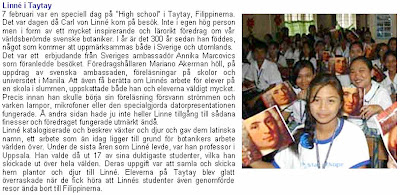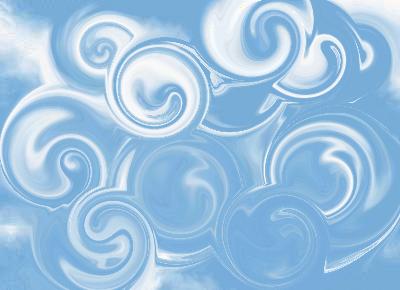The year 2007 marks the tercentenary of the birth of the renowned Swedish biologist Carl Linnaeus (1707-1778). In Manila special events take place, to enhance his unique contribution in terms of systematic research. Indeed, Linnaeus was an enthusiastic man, a researcher who believed that curiosity was the only firm basis for scientific thought. Interested in mapping, studying, cataloguing and classifying the living species, Linnaeus wanted to understand the organizational principles underlying God’s Creation. The Linnaean approach involves a systematic giving of names to the natural species or binary nomenclature, which is an attempt to clarify and simplify the scientific dialog, raising it to a universal level. Exploration, medicine, geology, anthropology, ecology and philosophy were among the many interests of Linnaeus. Considering the scientific and artistic developments of the Age of Reason, Linnaeus’ deductive approach and his systematic classification of life can be put in context. Searching for species to be discovered, collected, examined, described, named and classified, Linnaeus traveled across Scandinavia. He also played a key role in leading seventeen of his students to important scientific journeys all around the world. Conceived as an interdisciplinary forum, the Manila Series of Lectures on Linnaeus gather together the Sciences and the Arts, to focus on Linnaeus’ extraordinary contribution which was to lead us to a better understanding of the world that surrounds us.
 Program Topics
Program Topics
1. A tribute to Linnaeus: the presence of flora and fauna in the visual arts throughout the ages
2. An exemplary Swede: Linnaeus’ place among his other famous compatriots
3. Linnaeus: his life and work
4. Linnaeus in the 18th Century context: scientific and artistic developments in the Age of Reason
5. Linnaeus as researcher: a multifaceted man and his methodology
6. The scientific journeys across Sweden and abroad
7. Scandinavian botanical and animal species
8. Realistic ways of recording a botanical specimen: herbarium, sketches, drawings and paintings, printed illustrations and photographs
9. Following God’s steps: Linnaeus names and orders Nature
10. Linnaeus’ two-word naming of the living species: Taxonomy, then an achievement and today a complication?
11. The process of classification: its peculiarities, difficulties and advantages, risks and importance
12. Classification and its types (accumulation, aggregation, group, collection, set, association, family, system; class, order, genera, species, variety)
13. Linnaeus’ rule-books: description, importance and projections
14. Attempting to map, name and classify the realm of fantasia
15. Surrealistic ways of recording reality: sculpture, painting, engraving and photography
16. Challenging the concept of category: the hybrid, its shape and symbolism
Program Target
In the Spirit of Linnaeus is intended for students at the higher levels of education
Program Aims
As a special program, In the Spirit of Linnaeus promotes learning and research education. Its main goals are:
1. To increase the interest for science among the students, focusing on the notions of research and the ordering of knowledge (in the past and today)
2. To present a multi-faceted image of Carl Linnaeus for the public, showing him in the context of the Age of Reason and underlining his sense of curiosity, systematic proceedings and creativity
3. To draw attention to the importance of systematic research as an invaluable tool relating to both comprehension and subsequent development
4. To show Linnaeus’ work as an exemplary starting point for new research projects
5. To stimulate an interdisciplinary approach in which the natural sciences are a component of a wider context that includes the visual arts, history, philosophy, literature, computer sciences, etc.
6. To inspire and prize investigative works
 Lecture Schedule
Lecture Schedule
1. British School Manila
Carl Linnaeus: Exploration, Creativity and System
Thursday, January 11, 2007, 2:30 – 5 pm
Music Room, 36th St University Park, Bonifacio Global City, Taguig, Manila
Info: 840-1570, website: www.britishschoolmanila.org
2. University of Santo Tomas
The Art of Linnaeus: From Curiosity to Apotheosis
Monday, January 15, 2007, 2 – 4 pm
Beato Angelico Audiovisual Room, College of Fine Arts & Design
España Avenue, Manila
Info: 406-1611 loc. 8390, website: www.ust.edu.ph
3. European International School
Carl Linnaeus: A Creative Person in the Age of Reason
Wednesday, January 17, 2007, 1:40 - 3:20 pm
Auditorium, 75 Swaziland St, Better Living, Subdivision Parañaque
Info: 776-1000 loc. 251, website: www.eis-manila.org
4. International School Manila
Linnaeus: Nature Exploration and Knowledge Systematization
Monday, January 22, 2007, 9 – 11 am
Fine Arts Theatre, University Park, Fort Bonifacio, Taguig, Manila
Info: 840-8400 loc. 251, website: www.ismanila.com
5. Ateneo de Manila University
Linnaeus and the Rara avis
Phenomenon
Wednesday, January 24, 2007, 4:30 – 6:30 pm
Ateneo Art Gallery, Katipunan Avenue, Loyola Heights, Quezon City
Info: 426-6488, website: www.ateneo.edu
6. Lyceum of the Philippines University
The Art of Classification: Linnaeus’ Passion and System
Friday, January 26, 2007, 1:30 – 3:30 pm
JPL Hall of Freedom, Muralla Street, Intramuros, Manila
Info: 527-2303, website: www.lyceumphil.edu.ph
7. Mahatma Gandhi International School
Classification: A Fundamental Tool involving Surprises, Advantages and Risks?
Tuesday, January 30, 2007, 12:30 – 2:30 pm
Auditorium, 3270 Armstrong Ave., Merville Access Road, Pasay City
Info: 776-1165, website: www.mgis.com.ph
8. De La Salle University
Nature and Art: Species Exploration in the Spirit of Linnaeus
Wednesday, January 31, 2007, 12:30 – 2:30 pm
Waldo Perfecto Seminar Hall, SPS Building, 2401 Taft Avenue, Manila
Info: 524-4611 loc. 521 or 522, website: www.dlsu.edu.ph
9. Feati University
Linnaeus and Order: Nature and Its Architectural Projections
Friday, February 2, 2007, 2 – 4 pm
Audiovisual Room, Administration Bldg., Helios Street, Santa Cruz, Manila
Info: 733-8321, website: www.featiu.edu.ph
10. Star of Hope School
Linnaeus’ Systematic Approach to Nature and Its Implications
Friday, February 7, 2007, 10:30 – 13 pm
Main Room, Taytay
 2007 heralds the 60 Years of Diplomatic Relations between Philippines and Sweden and the 300th anniversary of the birth of Carl Linnaeus
2007 heralds the 60 Years of Diplomatic Relations between Philippines and Sweden and the 300th anniversary of the birth of Carl Linnaeus
To highlight these two momentous events, the Embassy of Sweden in Manila together with Mr. Mariano Akerman, Researcher and Lecturer, will organize a series of lectures with different universities and educational institutions entitled In the Spirit of Linnaeus, a Tercentenary Lectures on Science and Art from 11 January to 22 February 2007 that will enhance Linnaeus' consistent contribution in the field of systematic research. We hope that these will contribute to a better understanding of the world that surrounds us as a result of Linnaeus' curiosity and inventiveness.
The qualities for which Carl Linnaeus, Sweden’s most famous and outstanding scientist of all time, is still remembered – innovation, creativity, progressiveness – are qualities which people around the world associate with Sweden. Perhaps, some people look at him primarily as a traveller and explorer of his own country while to others he is the father of the modern classification of flora and fauna. But he was also an inspiring teacher who sent his students on voyages of scientific discovery all over the world.
He lived at a time of enormous discovery when science was seeking to explain the world around us. His untiring and resolute endeavours in the description of the living world laid the groundwork for the modern international scientific systems of classification and naming of animals and plants. He lived at a time, possibly the very last time, when one person could accomplish this single-handedly provided he was willing to pay the price. The price was a heavy one - for much of his life, he was financially insecure and his health suffered due to overwork.
We would like to take this opportunity to encourage you to participate in the Linnaeus Lecture series. Your unwavering support to promote inter-disciplinary involvement and the exchange of ideas in the Linnaeus Forum will indeed increase the interest of our young people in science and research.


















